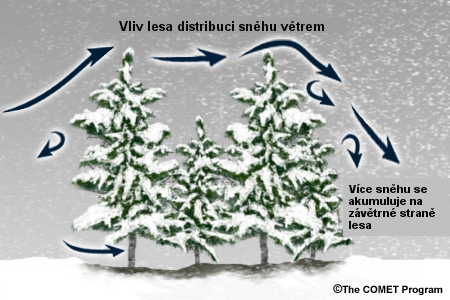
credits:
�The COMET Program
copyright terms:
COMET Standard Terms of Use
description:
Impact of airflow in forests during snow and blowing snow
|
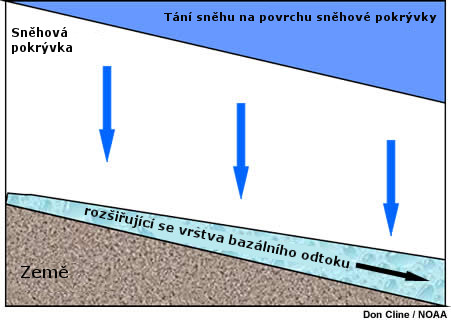
credits:
Don Cline / NOAA
copyright terms:
COMET Standard Terms of Use
description:
Conceptual diagram of meltwater creating a basal flow that increases in volume as it moves downslope.
|
|
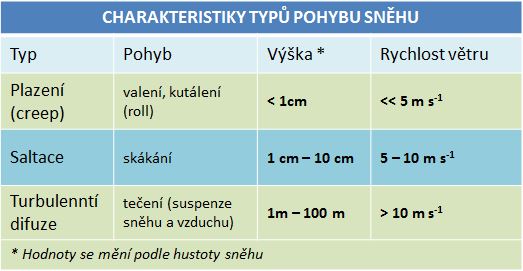
credits:
The COMET Program / NCU
copyright terms:
COMET Standard Terms of Use
description:
Table of types of blowing snow, snow motion, height of blowing snow and windspeed
|
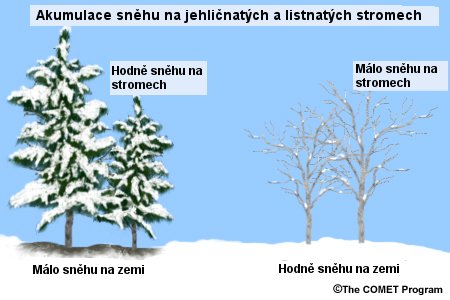
credits:
�The COMET Program
copyright terms:
COMET Standard Terms of Use
description:
differences in snow accumulation in coniferous versus deciduous forests
|
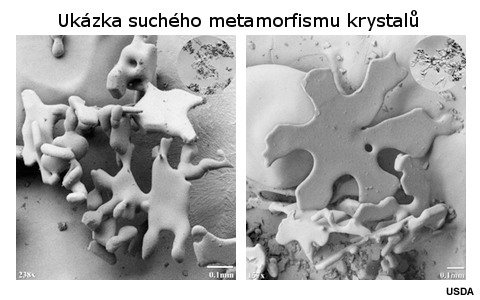
credits:
USDA
copyright terms:
COMET Standard Terms of Use
description:
An electron microscope view of snow crystals altered through dry metamorphism
|

credits:
Don Cline / NOAA
copyright terms:
COMET Standard Terms of Use
description:
Conceptual drawing showing initial melting along snow crystals, in which a thin film of water builds up along the outer edges and small amounts of water can then flow downward. Later, the thin film becomes quite thick, eventually filling in all of the pore space, and water can now freely and rapidly downward
|
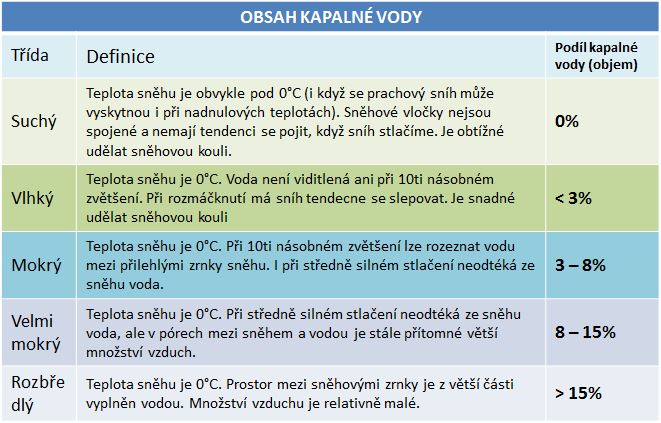
credits:
USACE
copyright terms:
COMET Standard Terms of Use
description:
Classification table showing the liquid water content of various types of snow (from dry snow to slush)
|
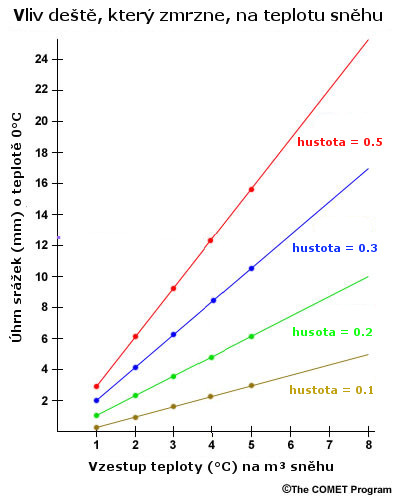
credits:
�The COMET Program
copyright terms:
COMET Standard Terms of Use
description:
The impact on snowpack temperature when rain falls on and then freezes within the snowpack. Shown for differnt snowpack densities and rainfall amounts.
|

credits:
�The COMET Program
copyright terms:
COMET Standard Terms of Use
description:
The impact on snowpack temperature when rain falls on and then freezes within the snowpack. Shown for differnt snowpack densities and rainfall amounts.
|
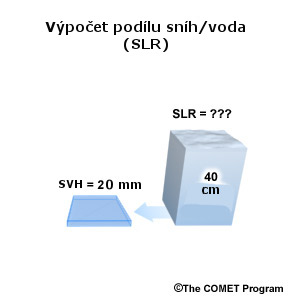
credits:
�The COMET Program
copyright terms:
COMET Standard Terms of Use
description:
Snowpack that is 40 depth units high melts into a volume of water that is 2 units high.
|
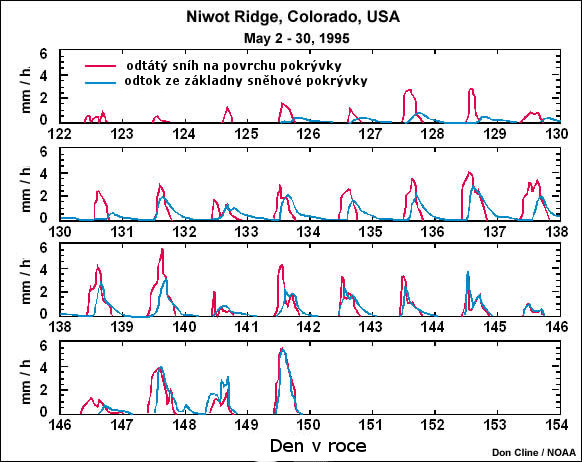
credits:
Don Cline / NOAA
copyright terms:
COMET Standard Terms of Use
description:
Graph of snowmelt at top surface of snowpack and snowmelt draining from bottom of snowpack in Niwot Ridge, Colorado, USA for each day of May, 1995.
|
|
|

credits:
�The COMET Program
copyright terms:
COMET Standard Terms of Use
description:
Temperature profile of a snowpack, night and day.
|
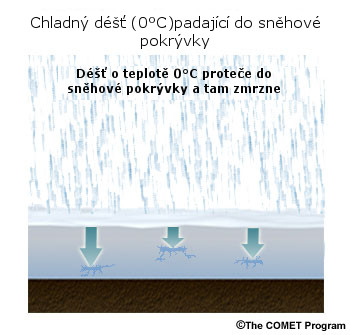
credits:
�The COMET Program
copyright terms:
COMET Standard Terms of Use
description:
Rain falling into snowpack begins to freeze, and imparts large amounts of heat energy during phase change
|
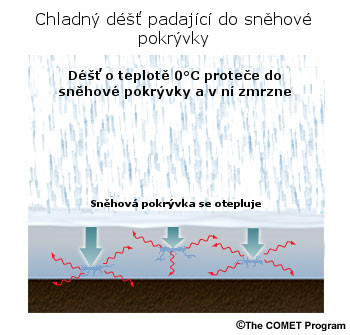
credits:
�The COMET Program
copyright terms:
COMET Standard Terms of Use
description:
Rain falling into snowpack begins to freeze, and imparts large amounts of heat energy during phase change
|
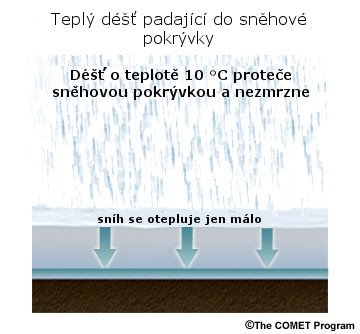
credits:
�The COMET Program
copyright terms:
COMET Standard Terms of Use
description:
Rain falling into snowpack does not freeze, and imparts small amounts of heat energy to the rest of the pack.
|
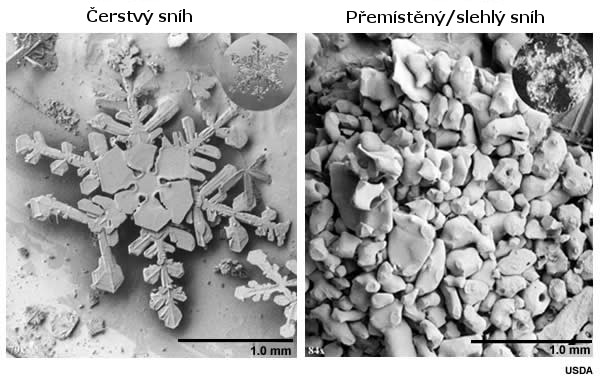
credits:
USDA
copyright terms:
COMET Standard Terms of Use
description:
An electron microscope view of a pristine dendrite and aged, windblown snow crystals.
|
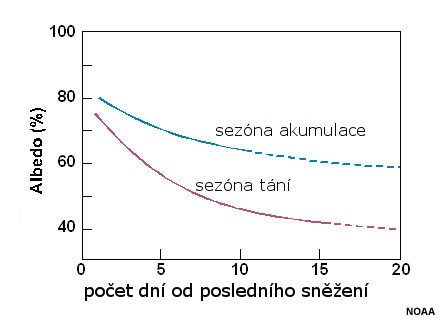
credits:
NOAA
copyright terms:
COMET Standard Terms of Use
description:
Plot of snow albedo versus time since the last snowfall (in days).
|
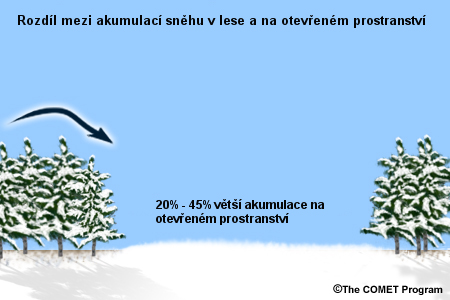
credits:
�The COMET Program
copyright terms:
COMET Standard Terms of Use
description:
differences in snow accumulation in an open clearing between forested areas
|

credits:
Jerry Roberts
copyright terms:
COMET Standard Terms of Use
description:
Macro photograph showing snow being transported by wind at the snow surface
|
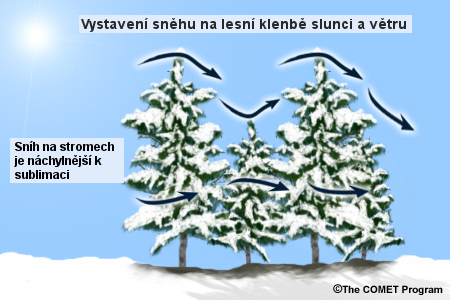
credits:
�The COMET Program
copyright terms:
COMET Standard Terms of Use
description:
Illustration of how snow in the forest canopy is more exposed to the effects of wind and sun
|
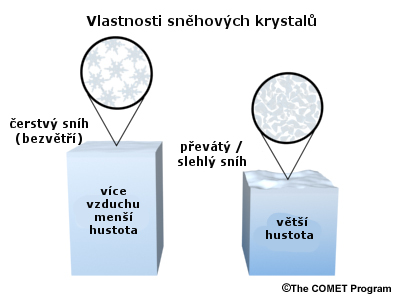
credits:
�The COMET Program
copyright terms:
COMET Standard Terms of Use
description:
Pristine snow crystals, in this case dendrites, shown over a tall column of snowpack. This is compared to older, more rounded snow crystals that reside in a shorter, more dense snowpack.
|
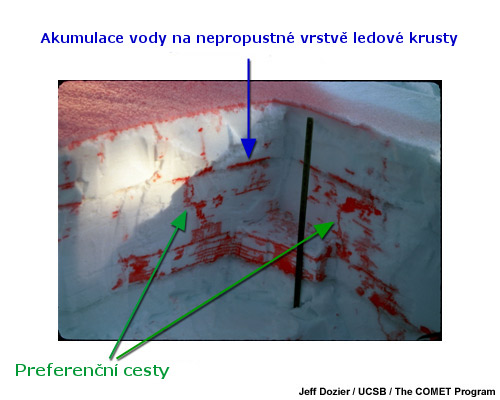
credits:
Jeff Dozier / UCSB / The COMET Program
copyright terms:
COMET Standard Terms of Use
description:
Photograph of snowpack that has been dyed red to show how water moves through it. Horizontal red patches exist where ice lenses have formed. Long, mostly vertical channels of red highlight preferential flow paths.
|
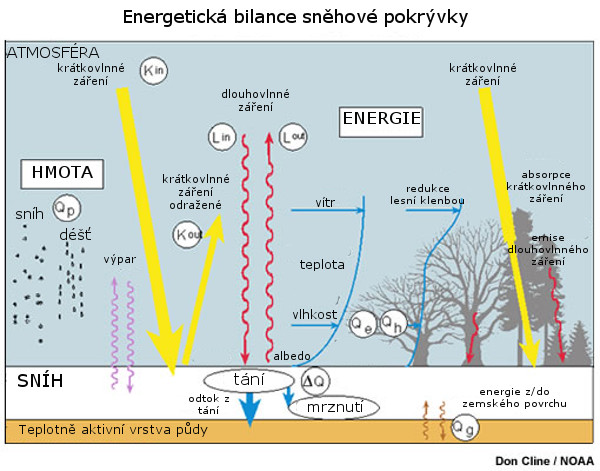
credits:
Don Cline / NOAA
copyright terms:
COMET Standard Terms of Use
description:
Energy budget for snowpack, including long wave and short wave radiation, turbulent transfer of latent and sensible heat, ground conduction and advected heat.
|
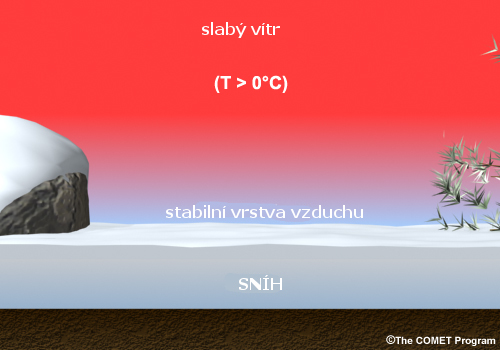
credits:
�The COMET Program
copyright terms:
COMET Standard Terms of Use
description:
graphic of snow energy exchange with the atmosphere under calm winds
|
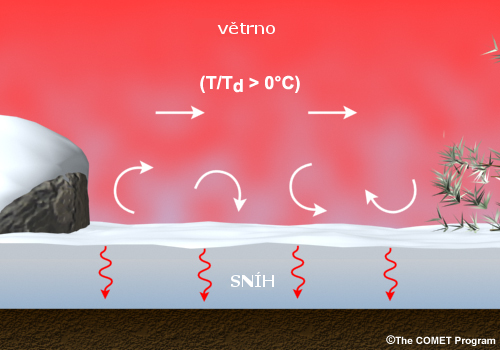
credits:
�The COMET Program
copyright terms:
COMET Standard Terms of Use
description:
graphic of snow energy exchange with the atmosphere under windy and humid conditions
|
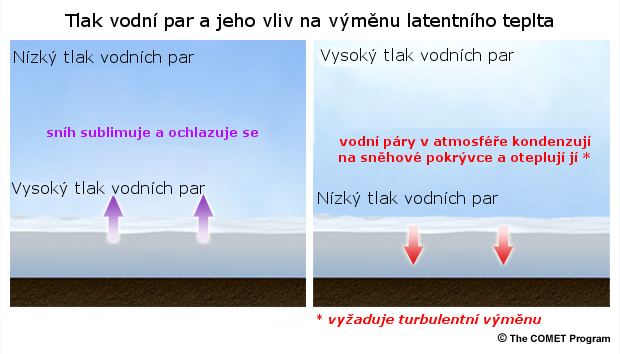
credits:
�The COMET Program
copyright terms:
COMET Standard Terms of Use
description:
Environmental vapor pressure that decreases with height versus environmental vapor pressure that increases with height. Vapor is diffused upward and away from the snow's surface in the first scenario, and toward it in the second.
|

credits:
�The COMET Program
copyright terms:
COMET Standard Terms of Use
description:
Graphic of latent heat exchange for 1)ice to water, 2) water to vapor, 3) ice to vapor
|

credits:
�The COMET Program
copyright terms:
COMET Standard Terms of Use
description:
Table of snow type and its typical temperature, water equivalent content, snow to liquid ratio conversion factor and snow to liquid ratio.
|
|
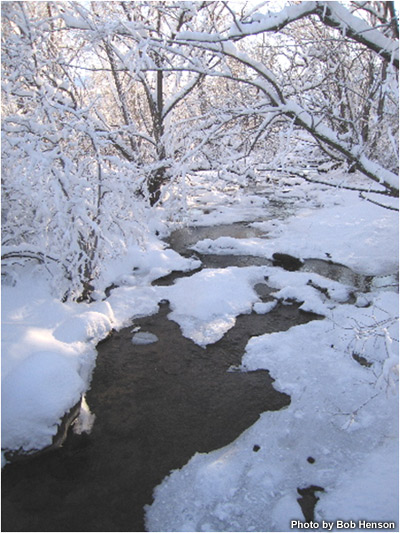
credits:
Photo by Bob Henson
copyright terms:
COMET Standard Terms of Use
description:
A stream moving through a wooded area that is snow-covered
|
|
|
|
|
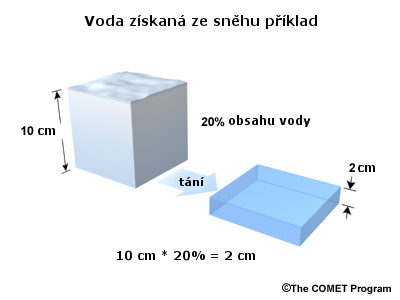
credits:
�The COMET Program
copyright terms:
COMET Standard Terms of Use
description:
water yield based on snow depth and percent water equivalent
|
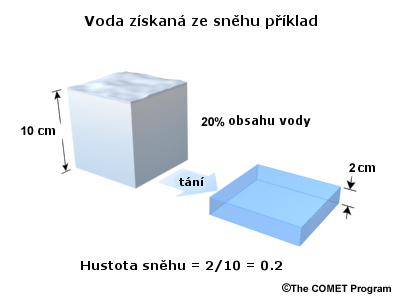
credits:
�The COMET Program
copyright terms:
COMET Standard Terms of Use
description:
water yield based on snow depth and snow-to-liquid ratio
|
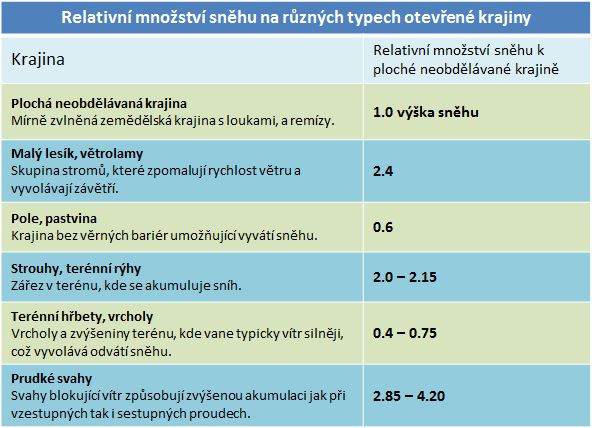
credits:
�The COMET Program
copyright terms:
COMET Standard Terms of Use
description:
Table of relative accumulation amounts of snow on various types of landscapes
|

credits:
USDA
copyright terms:
COMET Standard Terms of Use
description:
An electron microscope view of snow crystals affected by wet metamorphosis
|